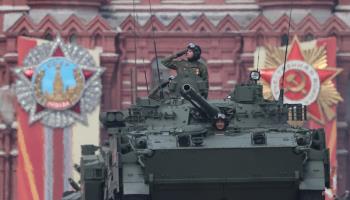Moscow is planning on building a larger and more capable military to confront NATO
The prospect of a ceasefire in Ukraine has raised the possibility that Russia will be able to focus on rebuilding its battle-worn military. Russia’s war in Ukraine has served as a catalyst and testing ground for the transformation of its armed forces and defence industry. While much of its strategy remains rooted in traditional weaponry, innovations in drone warfare and missile technology point to a more technologically adaptive military doctrine.
What’s next
Subsidiary Impacts
- Russia could see arms exports increasing due to rising interest in its drones, electronic warfare and missiles.
- The Black Sea Fleet is likely to be overshadowed by the Turkish Navy.
- Russia will continue building advanced nuclear-powered submarines at a steady rate.
Analysis
Over the past three years, Russia has been embroiled in a high-intensity conflict against an adversary extensively supported by some of the world’s wealthiest and most militarily advanced states.
A military forged in battle
The war has served not only as a test of Russia’s military resilience but also as a real-time experiment for its future defence doctrine and industrial policy.
Despite considerable international sanctions and military losses, Russia appears poised to emerge from the current phase of the war politically, economically and socially intact, if not emboldened.
With a wealth of battlefield experience to draw upon, Moscow is likely to treat this war as a template for future wars. Preparations for a long-term military build-up are already underway, centred on lessons learned from the Ukrainian campaign.
The rise of combat drones
One of the most notable features of the Ukraine war has been the widespread and innovative use of drones — aerial, naval and, increasingly, on the ground — by both sides (see RUSSIA: The importance of aerial drones will rise – January 15, 2025).
For Russia, this has signalled a transformative moment in its approach to unmanned warfare. Minister of Defence Andrei Belousov previously supervised a large-scale civilian drone development initiative during his tenure as first deputy prime minister. By 2023, Russia had already assembled an expansive ecosystem of public and private entities engaged in drone research, development and production.
Aerial drones are central to Russia’s new way of war
Militarily, Russia entered the war with a varied arsenal of long-range drones, both for reconnaissance and combat roles. However, the demands of war forced the military to innovate.
The ‘Geran’ (Geranium) — a locally produced version of the Iranian Shahed strike drone — has been used extensively. Although rudimentary, these systems are inexpensive and effective at overwhelming air defences.
Simultaneously, short-range drones with a range of around ten miles have become highly sophisticated tools for tactical reconnaissance and precision strikes.
Belousov remains an enthusiastic advocate for unmanned systems of all types, and his ministry continues to invest in their further development.
The role of traditional weapons
While drones have added new dimensions to Russian military operations, they have not displaced traditional armaments. Tanks, artillery and armoured vehicles remain central to Russia’s doctrine of attritional warfare.
Major offensives during the war were consistently spearheaded by armoured formations, supported by massed artillery barrages. Despite heavy losses in equipment and personnel, Russia demonstrated a capacity to sustain these operations through robust logistics and industrial repair networks.
Russia’s industrial base for producing tanks and armoured vehicles is extensive and well-established. This infrastructure has enabled the armed forces to absorb battlefield losses and replenish frontline units rapidly. According to independent analysis, Russia has maintained a significant number of active armoured units despite ongoing attrition.
Moscow plans to continue manufacturing proven and widely deployed models such as the T-72 and T-90. The newer T-14 Armata, representing a radical departure in design, will likely remain a lower priority due to its cost and complexity.
Instead, Russia is expected to focus on enhancing existing platforms with integrated systems such as drones and radar arrays. In the long term, partial or full automation of tank crew functions may be introduced, but such advances remain on the horizon.
Missile capabilities
Another key outcome of the war has been the validation of ballistic missile systems as a strategic asset. Russia’s use of ballistic and aero-ballistic missiles such as the Iskander and Kinzhal (NATO: Stone and Killjoy) proved particularly effective against static Ukrainian targets.
In contrast, Ukrainian defences intercepted many cruise missiles. As a result, future investment is likely to prioritise ballistic and quasi-ballistic missiles, including new systems such as the ‘Oreshnik’ intermediate-range ballistic missile (see UKRAINE/RUSSIA: Oreshnik missile may be used again – December 12, 2024).
Naval forces: a declining strategic priority
The Russian Navy’s performance during the Ukraine conflict, particularly the Black Sea Fleet, has been underwhelming (see RUSSIA: Black Sea Fleet is not yet defeated – April 25, 2024).
Despite the fleet being modernised prior to the war, it failed to achieve any significant strategic objectives. Its surface vessels were forced to retreat into fortified harbours to avoid Ukrainian attacks, particularly from unmanned surface vessels. Even in protected environments, these ships remained vulnerable to precision-guided strikes.
The Navy is likely to lose out in the battle for procurement funds
While naval platforms have been used to launch cruise missiles, these operations could be conducted more efficiently and at a lower cost using land-based launchers. In the post-war budgetary contest for defence resources, recent failures are likely to weaken the Navy’s standing compared to the more battle-tested ground forces.
Procurement priorities
As Russia prepares to reconstitute its battle-hardened and expanded military, several key technologies will be prioritised in future procurement that is funded by record-high defence spending (see RUSSIA: Defence output will keep growing – March 7, 2025):
- Tanks and armoured vehicles. Continued heavy use in attritional warfare will necessitate expanded production capacity. Civilian heavy industry may be co-opted to support manufacturing and repair.
- Artillery systems. Towed and self-propelled artillery will remain a high priority. Existing manufacturers will scale up output to replenish losses and meet new demand.
- Air defence systems. These systems have suffered substantial wartime losses, particularly at the tactical level. Their complexity limits outsourcing, so expansion will be confined to specialist facilities, principally operated by Almez-Antei.
- Missile systems. Ballistic missile programmes will require long-term investment in dedicated infrastructure. Given their strategic value, they are expected to receive substantial backing.
- Combat drones and robotics. The continued emphasis on drones will also expand land-based unmanned combat systems, accelerating field testing and deployment.
- Technology acquisition. Sanctions continue to restrict access to advanced electronic components. Russia is expected to intensify efforts to secure supply chains via alternative international partners.
Industrial centralisation and nationalisation
A broader economic trend accompanying Russia’s military evolution has been the increasing centralisation and nationalisation of its military-industrial base. While state control of defence enterprises is not new, recent moves indicate a deepening consolidation.
Key industrial sectors — metallurgy, transport and logistics — are being brought under state control, often justified on grounds of “strategic importance.” While most large-scale producers of tanks and artillery systems are already state-owned, the burgeoning drone sector has until now been characterised by innovation, flexibility and private entrepreneurship.
Many so-called “people’s drones” were developed by independent companies and funded through public donations. This dynamic is changing rapidly. The Russian government has begun seizing intellectual property rights associated with weapons production, allowing it to acquire private R&D assets forcibly through court orders. How this will affect innovation in a previously agile sector remains uncertain.



